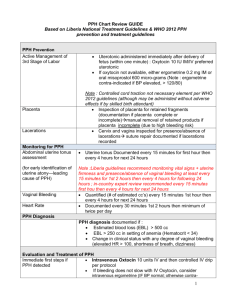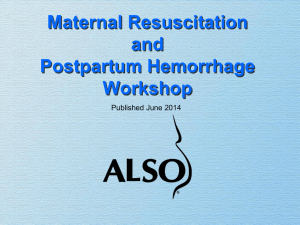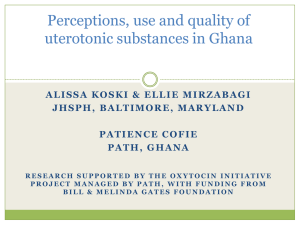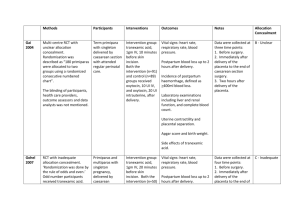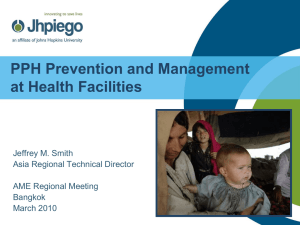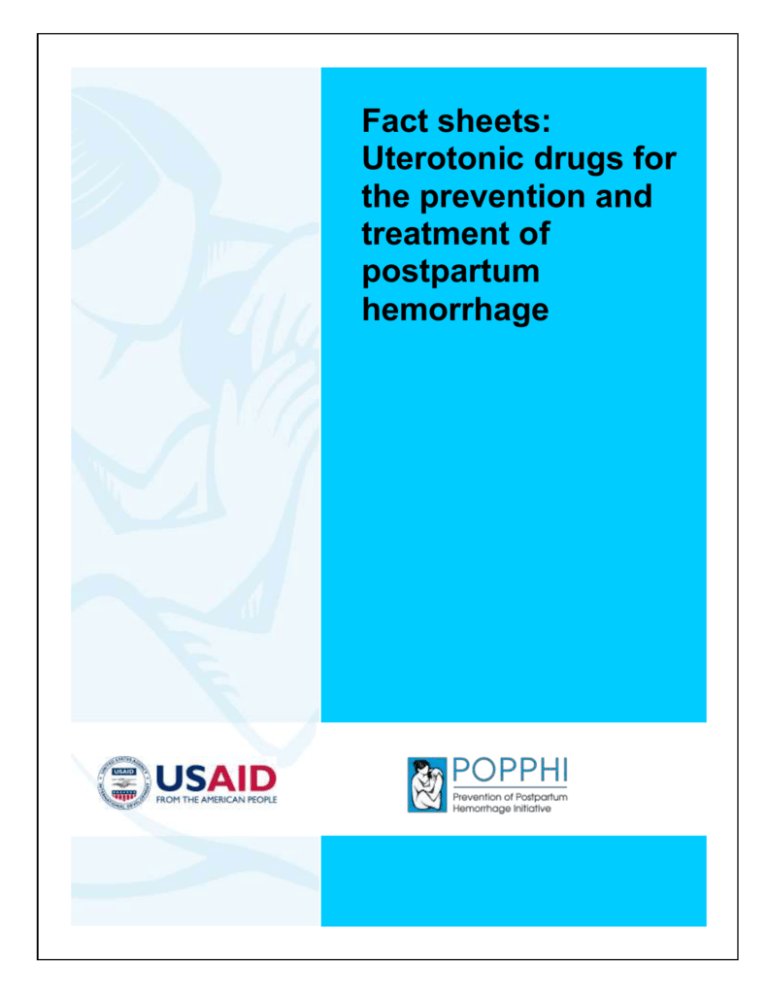
Fact sheets:
Uterotonic drugs for
the prevention and
treatment of
postpartum
hemorrhage
Copyright © 2008, Program for Appropriate Technology in Health (PATH). All rights
reserved. The material in this document may be freely used for educational or
noncommercial purposes, provided that the material is accompanied by an
acknowledgement line.
Suggested citation: POPPHI. Fact sheets: Uterotonic drugs for the prevention and treatment
of postpartum hemorrhage. Seattle: PATH; 2008.
Fact sheets: Uterotonic drugs for the prevention
and treatment of postpartum hemorrhage
2008
Prevention of Postpartum Hemorrhage
Initiative (POPPHI)
The development of this document was made possible through support provided to the POPPHI project by the Office of Health,
Infectious Diseases and Nutrition, Bureau for Global Health, US Agency for International Development, under the terms of
Subcontract No. 4-31-U-8954, under Contract No. GHS-I-00-03-00028. POPPHI is implemented by a collaborative effort between
PATH, RTI International, and EngenderHealth.
Fact sheets:
Uterotonic drugs for the prevention and treatment of postpartum hemorrhage
i
Table of contents
Uterotonic drugs ........................................................................................................ 1
Introduction ........................................................................................................ 1
Labor induction and augmentation ......................................................................... 2
Prevention of postpartum hemorrhage (PPH) .......................................................... 3
Treatment of PPH ................................................................................................ 5
Cost comparison .................................................................................................. 5
Oxytocin: Prevention and treatment of postpartum haemorrhage ..................................... 7
Background ........................................................................................................ 7
Evidence review .................................................................................................. 7
Presentation ....................................................................................................... 7
Indications and dosage......................................................................................... 7
Storage .............................................................................................................. 8
Misoprostol: Prevention and treatment of postpartum haemorrhage (PPH) ........................ 9
Background ........................................................................................................ 9
Evidence summary .............................................................................................. 9
Presentation ....................................................................................................... 9
Indications and dosage......................................................................................... 9
Storage ............................................................................................................ 10
Bibliography ............................................................................................................ 11
Endnotes ................................................................................................................. 13
List of tables
Table 1. Uterotonic drugs ............................................................................................ 1
Table 2. Dose, route, and precautions for oxytocin use for AMTSL ................................... 8
Table 3. Dose, route, and precautions for oxytocin use for PPH treatment ......................... 8
Table 4. Dose, route, and precautions for misoprostol use for PPH treatment 12 ................ 10
List of figures
Figure 1. UnijectTM device ............................................................................................ 7
ii
Fact sheets:
Uterotonic drugs for the prevention and treatment of postpartum hemorrhage
Acknowledgements
This document was developed by the Uterotonic Drugs and Devices (UDD) Task Force for
the prevention of postpartum hemorrhage initiative (POPPHI).
About POPPHI
The Prevention of Postpartum Hemorrhage Initiative (POPPHI) is a USAID-funded, five-year
project focusing on the reduction of postpartum hemorrhage, the single most important
cause of maternal deaths worldwide. The POPPHI project is led by PATH and includes four
partners: RTI International, EngenderHealth, the International Federation of Gynaecology
and Obstetrics (FIGO), and the International Confederation of Midwives (ICM).
For more information or additional copies of this report, please contact:
Deborah Armbruster, Project Director or
Susheela M. Engelbrecht, Senior Program Officer
PATH
1800 K St., NW, Suite 800
Washington, DC 20006
Tel: 202.822.0033
www.pphprevention.org
Fact sheets:
Uterotonic drugs for the prevention and treatment of postpartum hemorrhage
iii
Acronyms
iv
AMTSL
active management of the third stage of labor
CCT
controlled cord traction
EOC
essential obstetric care
HLD
high-level disinfection
IM
intra-muscular
IU
international units
IV
Intra-venous
MNH
maternal and newborn health
MPS
Making Pregnancy Safer
NGO
non-governmental organization
POPPHI
Prevention of Postpartum Hemorrhage Initiative
RCT
Randomized controlled trial
SBA
skilled birth attendant
USAID
United States Agency for International Development
WHO
World Health Organization
Fact sheets:
Uterotonic drugs for the prevention and treatment of postpartum hemorrhage
Uterotonic drugs
Introduction
Uterine stimulants (uterotonics or oxytocics) are medications given to cause a woman's
uterus to contract, or to increase the frequency and intensity of the contractions. The three
uterotonic drugs used most frequently are the oxytocins, prostaglandins, and ergot
alkaloids. Uterotonic drugs may be given intramuscularly (IM), intravenously (IV), and as a
tablet, gel, or suppository.
The following table outlines the uterotonic drugs included on the WHO list of essential
medications.
Table 1. Uterotonic drugs
Name of Drug/
Preparation
Oxytocin
Posterior pituitary
extract
Misoprostol
E1 analog
prostaglandin
Syntometrine
Combination of 5 IU
oxytocin plus 0.5 mg
ergometrine
Drug Action &
Effectiveness
Acts within 2-3
minutes
Effect lasts
about 15 - 30
minutes
Orally:
Acts within 3-5
minutes
Peak serum
concentration
between 18 –
34 minutes
Effect lasts 75
minutes
Combined rapid
action of
oxytocin and
sustained action
of ergometrine
Side Effects & Cautions*
No known contraindications for postpartum
use
No or minimal side effects
If used for labour induction or
augmentation: do not give oxytocin until at
least 6 hours after last Misoprostol dose
No known contraindications for postpartum
use
Shivering and transient elevated
temperature is common
Same cautions and contraindications as
ergometrine
Only for use in the postpartum
Side effects: nausea, vomiting, headaches
and hypertension
Contraindicated in women with or having
Ergometrine
Preparation of ergot
Acts within 6-7
minutes IM
Effect lasts 2-4
hours
history of hypertension, heart disease,
retained placenta, pre-eclampsia,
eclampsia
Only for use in the postpartum
Causes tonic contractions - may increase
risk of retained placenta
Side effects: nausea, vomiting, headaches
and hypertension
Do not use if drug is cloudy or has changed
color.
* Lists of side effects, cautions, and contraindications are not meant to be complete; evaluate each
client for sensitivities/appropriateness before use of any drug.
Fact sheets:
Uterotonic drugs for the prevention and treatment of postpartum hemorrhage
1
Uterotonic drugs are used to induce (start) or augment (speed) labour; facilitate uterine
contractions following a spontaneous abortion; prevent postpartum haemorrhage during
active management of the third stage of labour; treat haemorrhage following childbirth or
abortion; and for other gynaecological reasons.
Labor induction and augmentation
Medical and obstetrical indications for and risks of labor induction and
augmentation
Uterine stimulants are used to induce, or begin, labour in certain circumstances when the
woman's labour has not started naturally. Labor may be induced for either maternal or fetal
indications. Induction of labor is undertaken when both of the following criteria are met:
Continuing the pregnancy is believed to be associated with greater maternal or fetal
risk than intervention to deliver the pregnancy, and
There is no contraindication to vaginal birth.
The magnitude of risk is influenced by factors such as gestational age, presence/absence of
fetal lung maturity, severity of the clinical condition, and cervical status. Some examples of
common medical and obstetrical conditions for which induction may be indicated include
chorioamnionitis, foetal demise, pregnancy-induced hypertension, premature rupture of
membranes, postterm pregnancy, maternal indications (e.g., diabetes mellitus, renal
disease, chronic pulmonary disease, chronic hypertension), foetal compromise (e.g., severe
foetal growth restriction, isoimmunisation), preeclampsia, and eclampsia.1
Augmentation refers to stimulation of uterine contractions when spontaneous contractions
have failed to result in progressive cervical dilatation or descent of the foetus. Uterine
stimulants can be used to augment existing uterine contractions, to increase their
frequency, duration and strength, when labour is not progressing well. If contractions are
inefficient and cephalopelvic disproportion and obstruction have been excluded,
the most probable cause of prolonged labor is inadequate uterine activity. Augmentation
should be considered if the frequency of contractions is less than 3 contractions per 10
minutes,2 each lasting less than 40 seconds,3 accompanied by failure of labour to progress.
Risks of induction and augmentation include: failure of induction and uterine
hyperstimulation. Uterine hyperstimulation may result in compromised utero-placental
perfusion, abruptio placentae, foetal hypoxia or asphyxia, and uterine rupture. All of these
may necessitate a need for emergent caesarean operation. Water intoxication can occur
with high concentrations of oxytocin infused with large quantities of hypotonic solutions. The
antidiuretic effect usually is observed only after prolonged administration with at least 40mU
of oxytocin per minute. Induction and augmentation of labour have been shown to
be contributing factors to uterine atony after birth of the baby.4,5
Conditions for use of uterotonic drugs for induction and augmentation
Any health worker administering or dispensing a uterotonic drug should be authorized to do
so and be trained in the proper use of the drug and management of side and adverse
effects.
Labour induction and augmentation should only be attempted after:
2
weighing risks and benefits of induction or augmentation.
performing a careful assessment of the woman and foetus.
Fact sheets:
Uterotonic drugs for the prevention and treatment of postpartum hemorrhage
carefully counselling the woman regarding the indications for induction or
augmentation, the agents and methods of labour stimulation, and the possible need
for repeat induction or caesarean delivery.
Labour induction and augmentation should only be attempted in facilities where:
a caesarean operation can be performed in case of maternal or foetal distress.
personnel are available and skilled to consistently re-evaluate and document the
woman’s and foetus’ condition.
personnel are available and skilled to promptly recognize and manage an abnormal
change in either the woman's or foetus’ condition.
The pregnant woman should be monitored closely during induction or augmentation of
labour or cervical ripening and the woman should never be left alone.
Clear documentation of administration of any uterotonic drugs should be part of the
woman’s medical record. Documentation includes the time, route, and dosage of any
medications given, as well as a record of any side effects.
Uterotonic drugs used for induction and augmentation of labor
Oxytocin and misoprostol are the uterotonic drugs most commonly used for induction and
augmentation of labor. Refer to national or facility-based protocols for dosages and
regimen.
Safety concerns when using uterotonic drugs to induce or augment labor
When using oxytocin for induction or augmentation of labour:
Never administer oxytocin intramuscularly (IM) during labor.
Do not give oxytocin for further induction or augmentation until at least 6 hours after
last misoprostol dose.
When using misoprostol for induction or augmentation of labour:
Use 25 mcg tablets. When 25 mcg tablets of misoprostol are not available, do not break
higher dose tablets (usually 200 mcg) and administer for induction. When 200 mcg
tablets are broken, the exact dose of misoprostol being give to the woman is not reliable
and could be dangerous. If more than 25 mcg of misoprostol is administered during
labor, this could cause a uterine rupture and / or the death of the baby.
Prevention of postpartum hemorrhage (PPH)
Medical and obstetrical indications for administering uterotonic drugs for active
management of the third stage of labor (AMTSL)
AMTSL should be offered routinely to all women by all skilled birth attendants. Active
management involves a group of interventions that include administration of a prophylactic
uterotonic after delivery of the baby, controlled cord traction to deliver the placenta, and
uterine massage after delivery of the placenta to decrease the incidence and severity of
postpartum haemorrhage.
Administration of a uterotonic drug stimulates uterine contractions that facilitate
separation of the placenta from the uterine wall resulting in rapid delivery of the
placenta and stimulates uterine contractions that compress maternal blood vessels at
the placental site after delivery of the placenta
Fact sheets:
Uterotonic drugs for the prevention and treatment of postpartum hemorrhage
3
Controlled cord traction (CCT) facilitates rapid delivery of the placenta and emptying
of the uterus
Uterine massage after delivery of the placenta stimulates uterine contractions and
removes clots that may inhibit uterine contraction.
Active management is associated with a lower incidence of blood loss, postpartum
haemorrhage (PPH), need for blood transfusion, prolonged third stage of labour, and
maternal anaemia. There are no apparent adverse effects of AMTSL on the baby.
Conditions for use of uterotonic drugs for the prevention of PPH
Any health worker administering or dispensing a uterotonic drug should be authorized to do
so and be trained in the proper use of the drug and management of side and adverse
effects.
Clear documentation of administration of any uterotonic drugs should be part of the
woman’s medical record. Documentation includes the time, route, and dosage of any
medications given, as well as a record of any side effects.
Uterotonic drugs used for AMTSL / prevention of PPH
The uterotonic drug of choice for AMTSL is oxytocin 10 IU IM.
In the context of AMTSL, if oxytocin is available:
Skilled attendants should offer oxytocin to all women for prevention of PPH in
preference to ergometrine/methylergometrine.
This recommendation places a high value on avoiding adverse effects of ergometrine
and assumes similar benefit for oxytocin and ergometrine for preventing PPH 6.
Skilled attendants should offer oxytocin for prevention of PPH in preference to oral
misoprostol (600 mcg).
This recommendation places a high value on the relative benefits of oxytocin in
preventing blood loss compared to misoprostol, as well as the increased adverse
effects of misoprostol compared to oxytocin6.
In the context of AMTSL, if oxytocin is not available but other injectable uterotonics are
available:
Skilled attendants should offer ergometrine/methylergometrine or the fixed drug
combination of oxytocin and ergometrine to women without hypertension or heart
disease for prevention of PPH6.
Skilled attendants should offer 600 micrograms (mcg) misoprostol orally for
prevention of PPH to women with hypertension or heart disease for prevention of
PPH7.
In the context of AMTSL, if injectable uterotonic drugs are not available, skilled attendants
should offer 600 micrograms (mcg) misoprostol orally for prevention of PPH .6,7
When controlled cord traction cannot be performed, administration of oxytocin or
misoprostol within one minute of the baby’s birth will still stimulate uterine contractions that
will facilitate separation of the placenta from the uterine wall. Uterine massage may be
performed after delivery of the placenta.6,7
Safety concerns when using uterotonic drugs for prevention of PPH
Ergometrine is contraindicated in women with a history of hypertension, heart disease, preeclampsia, or eclampsia.
4
Fact sheets:
Uterotonic drugs for the prevention and treatment of postpartum hemorrhage
Treatment of PPH
Medical and obstetrical indications for administering uterotonic drugs for
treatment of PPH
After the baby is born, uterine muscles contract, clamping down on the uterine blood
vessels to help limit bleeding after the placenta has detached. If the muscles do not contract
strongly enough, PPH can occur, which can be life-threatening. PPH from uterine atony is a
serious problem that requires efficient and effective treatments to avert maternal morbidity
(severe anaemia, shock, and need for emergency laparotomy for uterine artery ligation or
hysterectomy) or mortality.
The earliest treatment options for primary PPH due to uterine atony include use of
uterotonic drugs to increase uterine muscle contractions that compress maternal blood
vessels at the site of placental separation.
Conditions for use of uterotonic drugs for treatment of PPH
Any health worker administering or dispensing a uterotonic drug should be authorized to do
so and be trained in the proper use of the drug and management of side and adverse
effects.
Clear documentation of administration of any uterotonic drugs should be part of the
woman’s medical record. Documentation includes the time, route, and dosage of any
medications given, as well as a record of any side effects.
Uterotonic drugs used for treatment of PPH
Any of the uterotonic drugs (ergometrine, oxytocin and prostaglandins) can be given
together or sequentially for treatment of PPH.
Safety concerns when using uterotonic drugs for treatment of PPH
Ergometrine is contraindicated in women with a history of hypertension, heart disease, preeclampsia, or eclampsia.
Cost comparison
The acquisition costs of oxytocin and ergometrine are essentially the same, 8 while the fixed
drug combination of oxytocin and ergometrine is likely to be more expensive in most
countries than oxytocin or ergometrine alone. The price of misoprostol will depend upon the
manufacturer, the supply, and the demand. The reported manufacturers’ average price for
misoprostol in 2007 was 12.15 ¢/200 mcg tablet.
Administration costs of oxytocin, ergometrine, and the fixed drug combination of oxytocin
and ergometrine are likely to be generally equivalent. Administration costs of misoprostol
will be less because it does not require a syringe and needle, a skilled birth attendant
trained and authorized to administer injections, or consumables and supplies to ensure safe
injection and infection prevention practices.
Storage costs may be higher for ergometrine (and the fixed drug combination of oxytocin
and ergometrine) because it requires temperature-controlled transport and storage and
protection from light. Oxytocin is more stable and storage costs may be less than
ergometrine9. Costs for storage of misoprostol will be minimal as it is the most stable of the
three uterotonic drugs and can be stored at room temperature.
Fact sheets:
Uterotonic drugs for the prevention and treatment of postpartum hemorrhage
5
6
Fact sheets:
Uterotonic drugs for the prevention and treatment of postpartum hemorrhage
Oxytocin: Prevention and treatment of postpartum
haemorrhage
Note: Information on the use of oxytocin for induction and augmentation of labor can be
found in: PATH, the World Health Organization, and the United Nations Population Fund.
Essential Medicines for Reproductive Health: Guiding Principles for Their Inclusion on
National Medicines Lists. Seattle: PATH; 2006.
Background
Postpartum haemorrhage (PPH) is the single most important cause of maternal death
worldwide and one of the major causes of maternal death in developed and developing
countries, and increases morbidity in millions of women who give birth. Oxytocin is used to
stimulate uterine contractions to prevent and treat postpartum haemorrhage. In moderate
doses, oxytocin produces slow, generalized contractions with full relaxation in between; in
high doses, it produces sustained tonic contractions.
Evidence review
According to several reviews of evidence for effectiveness and safety of uterotonic drugs in
the prevention of postpartum haemorrhage, oxytocin used alone has shown effectiveness in
reducing the incidence of postpartum haemorrhage. The combination of ergometrine with
oxytocin is slightly superior for this outcome.10 However, maternal side effects are more
frequent in women treated with the combination regimen than with oxytocin alone. 10
Moreover, oxytocin is recommended for prevention of postpartum haemorrhage, since it is
more thermostable than ergometrine.
Presentation
Oxytocin is most often available in clear glass 1ml ampoules. Each ampoule will contain
either 5 IU or 10 IU.
Oxytocin 10 IU in the UnijectTM device—a prefilled, easy-to-use,
non-reusable syringe—is an advance in the method of delivering
oxytocin and is currently being used in pilot studies (Figure 1).
This delivery method ensures the correct dose is given with little
preparation and medical waste. The benefits of this device may
improve the ability of midwives and other health workers to
administer oxytocin within established facilities as well as outside
of hospital facilities, in emergencies, or in remote locations.
Figure 1. UnijectTM
device
Indications and dosage
Prevention of postpartum haemorrhage
Administering oxytocin within one minute of the baby’s birth will stimulate uterine
contractions that will facilitate separation of the placenta from the uterine wall and reduce
postpartum haemorrhage. Oxytocin can be administered with or without controlled cord
traction.
Fact sheets:
Uterotonic drugs for the prevention and treatment of postpartum hemorrhage
7
Table 2. Dose, route, and precautions for oxytocin use for AMTSL
11
Dose and route
IM: 10 units
If a woman has an IV when she gives birth, the provider can
either give 10 IU IM or 5 IU by slow IV injection
Precautions/
Contraindications
Before giving oxytocin, rule out the presence of another baby.
If oxytocin is administered when there is a second baby, there
is a small risk that the second baby could be trapped in the
uterus.
Treatment of postpartum haemorrhage
If the uterus fails to contract after delivery, oxytocin can be used to stimulate uterine
contractions and control postpartum haemorrhage:
Table 3. Dose, route, and precautions for oxytocin use for PPH treatment 12
Dose and route
IV: Infuse 20 units in 1 L IV fluids at 60 drops per minute
IM: 10 units
Continuing dose
IV: Infuse 20 units in 1 L IV fluids at 40 drops per minute
Maximum dose
Not more than 3 L of IV fluids containing oxytocin
Precautions/
Contraindications
Do not give as an IV bolus
Oxytocin may be used for prevention or treatment of postpartum hemorrhage if misoprostol
has been used for induction regardless of when the last dose of misoprostol was
administered.
Storage
The stability of a drug is defined by how well it maintains active ingredient potency (and
other measures such as pH) when stored over time. Pharmaceutical companies conduct
stability studies to determine the appropriate shelf-life, storage conditions, and expiration
dating for safe storage of the oxytocin they produce. A manufacturer will recommend
storage conditions based on the conditions under which he has performed stability studies,
and will set the expiry date to be consistent with this. It is therefore important to read
storage recommendations made by the manufacturer.
8
Fact sheets:
Uterotonic drugs for the prevention and treatment of postpartum hemorrhage
Misoprostol: Prevention and treatment of
postpartum haemorrhage (PPH)
Background
Misoprostol is a synthetic prostaglandin E1 (PGE1) analogue and is an alternative drug for AMTSL and
directions on its use for AMTSL is included in the International Federation of Gynaecology and
Obstetrics (FIGO)/International Confederation of Midwives (ICM) statement, Prevention and Treatment
of Post-partum Haemorrhage: New Advances for Low Resource Settings. Oxytocin is the uterotonic of
choice for AMTSL;6 however, administration of an injection requires skills and sterile equipment for
safe administration. Oxytocin may be inactivated if exposed to high ambient temperatures.9
Misoprostol is reportedly more stable than oxytocin and has been administered by oral, sublingual and
rectal routes in several studies.13 Oral misoprostol is being viewed as an alternative drug for AMTSL
for women delivering in low-resource settings where oxytocin and a skilled birth attendant may not be
available and as a PPH treatment when used in combination with other uterotonics. It has also been
suggested that providers can provide misoprostol tablets where oxytocin is not available6 to nonskilled providers7 and to women themselves for the prevention of PPH. 14
Evidence summary
In prevention of postpartum haemorrhage, traditional uterotonics (oxytocin or ergot
derivates) outperform prostaglandin analogues because their onset of action is faster and,
in the case of oxytocin, there are fewer side effects 15. However, in situations where no
oxytocin is available, birth attendants’ skills are limited, or there are contraindications for
use of ergometrine, administering misoprostol soon after the birth of the baby reduces the
occurrence of haemorrhage 13, 14, 15.
Misoprostol is easier to store and administer than other uterotonics, and no cold storage is
needed.
Compared with other prostaglandin analogues, misoprostol is cheaper than conventional
uterotonics, can be administered by multiple routes and without a syringe, and can be
stored at room temperature.
Presentation
Misoprostol is most often available in tablet form. Each tablet will contain 25, 100, or 200
mcg.
Indications and dosage
Prevention of postpartum haemorrhage: Active management of the third stage of
labour (AMTSL)
In situations where no oxytocin is available, administering misoprostol by mouth to the
mother within one minute of the baby’s birth stimulates uterine contractions that will
facilitate separation of the placenta from the uterine wall. Before giving misoprostol it is
important to rule out the presence of another baby (undelivered twin). If misoprostol is
administered when there is a second baby, there is a small risk that the second baby could
be trapped in the uterus.
The steps for administering misoprostol for AMTSL include:
Fact sheets:
Uterotonic drugs for the prevention and treatment of postpartum hemorrhage
9
(1) Before giving misoprostol, gently palpate the woman’s abdomen to rule out the
presence of another baby. At this point, do not massage the uterus.
(2) If there is not another baby, begin the procedure by giving the woman misoprostol 600
mcg orally.
(3) Perform controlled cord traction (CCT).
(4) Perform uterine massage after the delivery of the placenta.7
Prevention of postpartum haemorrhage: Use of misoprostol in the absence of
AMTSL
In situations where no oxytocin is available or birth attendants’ skills are limited,
administration of misoprostol within one minute of the baby’s birth will still stimulate uterine
contractions that will facilitate separation of the placenta from the uterine wall and reduce
postpartum haemorrhage. When CCT is not performed, the steps to prevent PPH include:
(1) Before administering misoprostol, gently palpate the woman’s abdomen to rule
out the presence of another baby. At this point, do not massage the uterus.
(2) If there is not another baby, begin the procedure by giving the woman
misoprostol 600 mcg orally within one minute of birth.
(3) Perform uterine massage after the delivery of the placenta.7
Treatment of postpartum haemorrhage
If the uterus fails to contract after delivery, misoprostol can be used to stimulate uterine
contractions and control postpartum haemorrhage:
Table 4. Dose, route, and precautions for misoprostol use for PPH treatment12
Rectal: Single dose of 1,000 mcg.
Maximum dose and route
Oral: Single dose of 600 mcg
Sublingual: Single dose of 800 mcg
Continuing dose
Unknown.
Precautions/
Contraindications
None
Storage
Misoprostol is relatively heat stable and may be stored at room temperature, away from
excess heat and moisture.
10
Fact sheets:
Uterotonic drugs for the prevention and treatment of postpartum hemorrhage
Bibliography
1
ACOG Committee on Practice Bulletins. Clinical Management Guidelines for ObstetricianGynecologists: Induction of Labor. ACOG Practice Bulletin Number 10, December 1999.
2
ACOG Committee on Practice Bulletins. Clinical Management Guidelines for ObstetricianGynecologists: Dystocia and Augmentation of Labor. ACOG Practice Bulletin Number 49, December
2003.
3
Chelmow, D. Pospartum hemorrhage: Prevention. BMJ Clinical Evidence: Web publication date: 01
Feb 2007 (based on July 2006 search). Accessed March 21, 2008. Available at:
http://clinicalevidence.bmj.com/ceweb/conditions/pac/1410/1410_background.jsp#aetiology
4
Derman RJ, Kodkany BS, Goudar SS, Gellar SE, Naik VA, Bellad M, et al. Oral misoprostol in
preventing postpartum haemorrhage in resource-poor communities: a randomised controlled trial.
Lancet 2006;368:1248-53.
5
Gulmezoglu AM, Villar J, Ngoc NN, Piaggio G, Carroli G, Adetoro L, et al. WHO Collaborative Group
to Evaluate Misoprostol in the Management of the Third Stage of Labour. WHO multicentre
randomised trial of misoprostol in the management of the third stage of labour. Lancet.
2001;358:689–95.
6
Hofmeyr GJ, Walraven G, Gulmezoglu AM, Maholwana B, Alfirevic Z, Villar J. Misoprostol to treat
postpartum haemorrhage: a systematic review. BJOG 2005;112:547-53.
7
Hogerzeil HV, Walker GJ, de Goeje MJ. Stability of injectable oxytocics in tropical climates: results
of field surveys and simulation studies on ergometrine, methylergometrine, and oxytocin. Geneva:
Action Programme on Essential Drugs and Vaccines, World Health Organization; 1993. WHO
Publication No. WHO/DPA/93.6.
8
Høj L, Cardoso P, Nielsen BB, Hvidman L, Nielsen J, Aaby P. Effect of sublingual misoprostol on
severe postpartum haemorrhage in a primary health centre in Guinea-Bissau: randomised double
blind clinical trial. BMJ 2005;331:723.
9
International Confederation of Midwives, International Federation of Gynaecology and Obstetrics.
Joint statement management of the third stage of labour to prevent post-partum haemorrhage.
The Hague: ICM; London: FIGO; 2003. Available at:
http://www.internationalmidwives.org/modules/ContentExpress/img_repository/final%20joint%20
statement%20active%20manange ment-eng%20with%20logo.pdf or
http://www.figo.org/content/PDF/PPH%20Joint%20Statement.pdf. Retrieved October 12, 2007.
10 International Confederation of Midwives, International Federation of Gynaecology and Obstetrics.
Prevention and Treatment of Post-partum Haemorrhage: New Advances for Low Resource Settings
- Joint statement. The Hague: ICM; London: FIGO; 2006. Available at:
http://pphprevention.org/files/FIGO-ICM_Statement_November2006_Final.pdf
11 JHPIEGO. Preventing Postpartum Hemorrhage: Active Management of the Third Stage of Labor—A
Maternal And Neonatal Health Program Best Practice. JHPIEGO TrainerNews. Washington, DC:
JHPIEGO; November 2001. Available at:
http://www.reproline.jhu.edu/english/6read/6issues/6jtn/
v4/tn110hemor.htm. Accessed September 28, 2007.
12 Maughan, KL, Heim, SW, and Galazka, SS. Preventing postpartum hemorrhage: Managing the
third stage of labor. Am Fam Physician 2006;73: 1025-8.
13 PATH, the World Health Organization, and the United Nations Population Fund. Essential Medicines
for Reproductive Health: Guiding Principles for Their Inclusion on National Medicines Lists. Seattle:
PATH; 2006.
Fact sheets:
Uterotonic drugs for the prevention and treatment of postpartum hemorrhage
11
14 Prendiville WJ, Elbourne D, McDonald S. Active versus expectant management in the third stage of
labour. Cochrane Database of Systematic Reviews 2000, Issue 3. Art. No.: CD000007. DOI:
10.1002/14651858.CD000007.
15 Prendiville WJ, Harding JE, Elbourne DR, Stirrat GM. The Bristol third stage trial: active versus
physiological management of the third stage of labour. British Medical Journal. 1988;297: 1295–
1300.
16 Rogers J, Wood J, McCandlish R, Ayers S, Truesdale A, Elbourne D. Active versus expectant
management of the third stage of labour: the Hinchingbrooke randomized controlled trial. Lancet.
1998;351:693–699.
17 Stephenson P. Active Management of the Third Stage of Labor: A Simple Practice to Prevent
Postpartum Hemorrhage. USAID Global Health Technical Brief. June 2005. MAQ website. Available
at: http://www.maqweb.org/techbriefs/tb13activemgmt.shtml. Accessed October 12, 2007.
18 World Health Organization (WHO). Managing Complications in Pregnancy and Childbirth: A guide
for midwives and doctors. Geneva: WHO; 2003. Available at: www.who.int/reproductivehealth/impac/Symptoms/Vaginal_bleeding_after_S25_S34.html and
http://www.who.int/reproductivehealth/impac/Symptoms/Unsatisfactory__progress_labour_S57_S67.html and
http://www.who.int/reproductive-health/impac/Clinical_Principles/Normal_labour_C57_C76.html.
Accessed October 12, 2007.
19 WHO. Medicine uses: misoprostol page. WHO Essential Medicines Library (EMLib) website.
Available at:
http://mednet3.who.int/EMLib/DiseaseTreatments/MedicineDetails.aspx?MedIDName=444@misop
rostol. Accessed February 6, 2006.
20 World Health Organization (WHO) Department of Making Pregnancy Safer. WHO
Recommendations for the prevention of postpartum haemorrhage. WHO: Geneva; 2006. Available
at:
www.who.int/making_pregnancy_safer/publications/WHORecommendationsforPPHaemorrhage.pdf
. Accessed January 2, 2008.
21 World Health Organization (WHO) Department of Making Pregnancy Safer. Prevention of
Postpartum Haemorrhage by Active Management of the Third Stage of Labour. MPS Technical
Update. Geneva, Switzerland: WHO; October 2007. Available at:
http://www.who.int/making_pregnancy_safer/publications/PPH_TechUpdate2.pdf. Accessed
October 12, 2007.
12
Fact sheets:
Uterotonic drugs for the prevention and treatment of postpartum hemorrhage
Endnotes
ACOG Committee on Practice Bulletins. Clinical Management Guidelines for ObstetricianGynecologists: Induction of Labor. ACOG Practice Bulletin Number 10, December 1999.
1
ACOG Committee on Practice Bulletins. Clinical Management Guidelines for Obstetrician-Gynecologists:
Dystocia and Augmentation of Labor. ACOG Practice Bulletin Number 49, December 2003.
2
World Health Organization (WHO). Managing Complications in Pregnancy and Childbirth: A guide for
midwives and doctors. Geneva: WHO; 2003. Available at: http://www.who.int/reproductivehealth/impac/Symptoms/Unsatisfactory__progress_labour_S57_S67.html. Accessed October 12,
2007.
3
Chelmow, D. Pospartum hemorrhage: Prevention. BMJ Clinical Evidence: Web publication date: 01
Feb 2007 (based on July 2006 search). Accessed March 21, 2008. Available at:
http://clinicalevidence.bmj.com/ceweb/conditions/pac/1410/1410_background.jsp#aetiology
4
Maughan, KL, Heim, SW, and Galazka, SS. Preventing postpartum hemorrhage: Managing the third
stage of labor. Am Fam Physician 2006;73: 1025-8.
5
World Health Organization (WHO) Department of Making Pregnancy Safer. WHO Recommendations
for the prevention of postpartum haemorrhage. WHO: Geneva; 2006. Available at:
www.who.int/making_pregnancy_safer/publications/WHORecommendationsforPPHaemorrhage.pdf.
Accessed January 2, 2008.
6
International Confederation of Midwives, International Federation of Gynaecology and Obstetrics.
Joint statement management of the third stage of labour to prevent post-partum haemorrhage. The
Hague: ICM; London: FIGO; 2003. Available at:
http://www.internationalmidwives.org/modules/ContentExpress/img_repository/final%20joint%20stat
ement%20active%20manange ment-eng%20with%20logo.pdf or
http://www.figo.org/content/PDF/PPH%20Joint%20Statement.pdf. Retrieved October 12, 2007.
7
8
Management Sciences for Health & World Health Organization (14) International Drug
Price Indicator 2005 Edition. 2006.
Hogerzeil HV, Walker GJ, de Goeje MJ. Stability of injectable oxytocics in tropical climates: results of
field surveys and simulation studies on ergometrine, methylergometrine, and oxytocin. Geneva: Action
Programme on Essential Drugs and Vaccines, World Health Organization; 1993. WHO Publication No.
WHO/DPA/93.6.
9
McDonald S, Abbott JM, Higgins SP. Prophylactic ergometrine-oxytocin versus oxytocin for the third
stage of labour. Cochrane Database of Systematic Reviews. 2004;1:CD000201.
10
World Health Organization (WHO). Managing Complications in Pregnancy and Childbirth: A guide for
midwives and doctors. Geneva: WHO; 2003. Available at: http://www.who.int/reproductivehealth/impac/Clinical_Principles/Normal_labour_C57_C76.html. Accessed October 12, 2007.
11
World Health Organization (WHO). Managing Complications in Pregnancy and Childbirth: A guide for
midwives and doctors. Geneva: WHO; 2003. Available at: www.who.int/reproductivehealth/impac/Symptoms/Vaginal_bleeding_after_S25_S34.html. Accessed October 12, 2007.
12
Gulmezoglu AM, Villar J, Ngoc NN, Piaggio G, Carroli G, Adetoro L, et al. WHO Collaborative Group
to Evaluate Misoprostol in the Management of the Third Stage of Labour. WHO multicentre randomised
trial of misoprostol in the management of the third stage of labour. Lancet. 2001;358:689–95.
13
13
Fact sheets:
Uterotonic drugs for the prevention and treatment of postpartum hemorrhage
Høj L, Cardoso P, Nielsen BB, Hvidman L, Nielsen J, Aaby P. Effect of sublingual misoprostol on
severe postpartum haemorrhage in a primary health centre in Guinea-Bissau: randomised double blind
clinical trial. BMJ 2005;331:723.
14
Derman RJ, Kodkany BS, Goudar SS, Gellar SE, Naik VA, Bellad M, et al. Oral misoprostol in
preventing postpartum haemorrhage in resource-poor communities: a randomised controlled trial.
Lancet 2006;368:1248-53.
15
14
Community-Based Prevention / Treatment of PPH

